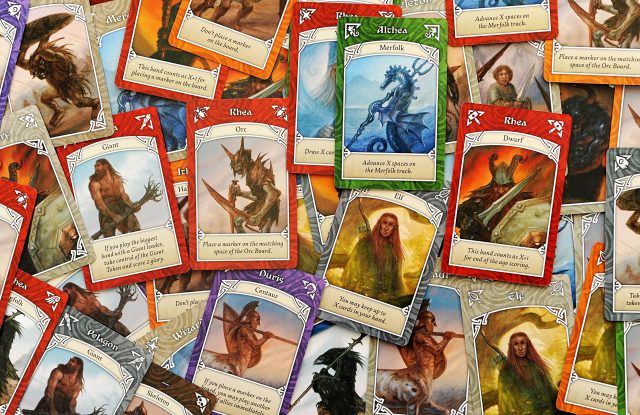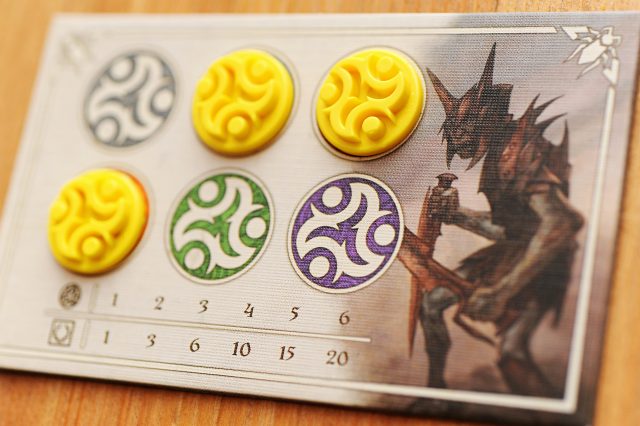The land of Ethnos has been thrust into chaos. At the end of the last age, the six kingdoms were in ruins and the twelve tribes were scattered across the countryside. It is a world in need of a new leader; someone who can unite the tribes and bring peace.
Ethnos is the fun new game by Paolo Mori, published by CMON and featuring art by legendary fantasy illustrator John Howe. Up to six players can fight over control of the six different kingdoms, over the course of three ages.
 The rules of Ethnos are incredibly simple. Each turn you either draw Tribe cards into your hand, or play a band of cards, and if possible, place a control marker in a region on the board. Ethnos combines set collection with area control, in an interesting and highly replayable way. Best of all the game plays very quickly. Turns don’t take too long, and then entire game usually lasts less than an hour.
The rules of Ethnos are incredibly simple. Each turn you either draw Tribe cards into your hand, or play a band of cards, and if possible, place a control marker in a region on the board. Ethnos combines set collection with area control, in an interesting and highly replayable way. Best of all the game plays very quickly. Turns don’t take too long, and then entire game usually lasts less than an hour.
Each game you play, you’ll only use six of the twelve Tribes in the game. You can select them randomly, or pick them for a customized experience. The Tribes each have a special power that can be activated when you play bands down. Each time you do, you choose one of the cards to be the band’s leader. Depending on the race of that Tribe, you access that power. Each of the different Tribes have members that hail from the six different kingdoms. You can only form a band of the same type of creature, or of creatures from the same kingdom.
 Collecting cards is simple. You take a card from the face up pool (if there are any), or from the top of the deck. The pool does not get replaced, when a card it taken, and often your only option will be pulling blindly from the deck. Laying down cards in a band takes a bit more consideration. Banding cards together requires them to be either the same race or from the same region (colour of the card). So you could play a group of Wizards down together, or you could play a bunch of creatures together from the Pelagon region for example.
Collecting cards is simple. You take a card from the face up pool (if there are any), or from the top of the deck. The pool does not get replaced, when a card it taken, and often your only option will be pulling blindly from the deck. Laying down cards in a band takes a bit more consideration. Banding cards together requires them to be either the same race or from the same region (colour of the card). So you could play a group of Wizards down together, or you could play a bunch of creatures together from the Pelagon region for example.
The card you choose to lay on top is he leader of the band. It determines two things: which region you can place a control marker in, and what special power you can use.
To lay down a control marker, the band you play has to contain more cards than you currently have control markers in the region. So, if I have two control markers in the green region, Althea, I have to play a band with an green leader AND it has to contain a minimum of three cards if I want to be able to lay down a control marker in that region. You can only ever lay down one control marker at a time.
 Depending on the situation, the powers of the leader of the band can really come in handy. Some of the races will give you an immediate advantage, while others can earn you points at the end of the age. Choosing a Minotaur leader allows you lay down a control marker for one less card than usual, a Winged Folk leader will allow you to lay your control marker in any Kingdom, and a Centaur leader will allow you to immediately lay down a second band. Meanwhile, a Halfling band doesn’t allow you to lay a control marker on the board, but it doubles the size of the band for scoring at the end of the round, a Merfolk band allows you to move up on the Merfolk track, earning you points at the end of the age, and Orc bands allow you to play a control marker on your Orc board, which also earns you points when you choose to cash them in. Each of the Tribes is helpful to you. Deciding which one is best to lead in a given situation can be key to victory.
Depending on the situation, the powers of the leader of the band can really come in handy. Some of the races will give you an immediate advantage, while others can earn you points at the end of the age. Choosing a Minotaur leader allows you lay down a control marker for one less card than usual, a Winged Folk leader will allow you to lay your control marker in any Kingdom, and a Centaur leader will allow you to immediately lay down a second band. Meanwhile, a Halfling band doesn’t allow you to lay a control marker on the board, but it doubles the size of the band for scoring at the end of the round, a Merfolk band allows you to move up on the Merfolk track, earning you points at the end of the age, and Orc bands allow you to play a control marker on your Orc board, which also earns you points when you choose to cash them in. Each of the Tribes is helpful to you. Deciding which one is best to lead in a given situation can be key to victory.
One of the really interesting aspects of the game is how playing bands works. The bands you play stay in front of you. Any cards you have left over in your hand get discarded to the face up draw pool. This means, if you can’t use the cards in your band, they then become available to the other players. The more you draw into your hand, the more potential aid you’re giving to your fellow players.
 Shuffled in to the bottom half of the deck of Tribe cards, are three Dragon cards. The first two revealed have no effect, but the age ends as soon as the third makes an appearance. This can make for some tense rounds, as you decide to push your luck further, or just cash in, and play down a band. Players will score points for the bands that they have played during the age. The bigger the band, the more points it’s worth. They’ll also score points for the regions they wield influence in. At the end of the first age, each region is worth points only to the player with the most control markers present. At the end of the second age, both the first and second player will score, and at the end of the third age, he top three will be awarded points. The value of each region is determined at the start of the game. Random point tokens are placed in each region and then arranged by value, from lowest to highest. The values range from 0-10, so there can be quite a swing from age to age.
Shuffled in to the bottom half of the deck of Tribe cards, are three Dragon cards. The first two revealed have no effect, but the age ends as soon as the third makes an appearance. This can make for some tense rounds, as you decide to push your luck further, or just cash in, and play down a band. Players will score points for the bands that they have played during the age. The bigger the band, the more points it’s worth. They’ll also score points for the regions they wield influence in. At the end of the first age, each region is worth points only to the player with the most control markers present. At the end of the second age, both the first and second player will score, and at the end of the third age, he top three will be awarded points. The value of each region is determined at the start of the game. Random point tokens are placed in each region and then arranged by value, from lowest to highest. The values range from 0-10, so there can be quite a swing from age to age.
I am a big fan of Ethnos. I think Mori has done a great job balancing the desire to collect bigger and bigger bands, with the punishment of helping your opponents, by making cards available to them when you can’t use them. The mixture of the different races is interesting and the presence or absence of any particular one, dramatically changes the feel of the game. It’s really cool to see what races are in, and then start to formulate a strategy based on them. Best of all (to me anyway), Ethnos plays quickly! Most turns consist of drawing cards, and when you do decide to play a band, you’ve probably decided long in advance. That’s not to say there isn’t interesting choices to make. Just that there’s not a lot of downtime between each one, and they’re pretty quick to decide upon.
Ethnos is a game that could easily have an expansion, but it would be just fine without one. The Tribes are interesting as they are, and with only six of the twelve used each game, there are plenty of different combinations to explore.
Some people may be bothered by the random luck of the draw element to Ethnos, but by using the powers of the Tribes effectively, you can do a lot to mitigate that element. For me, this is a homerun! I’m always look forward to getting it to the table again. Definitely give Ethnos a look!
Comments
No comments yet! Be the first!